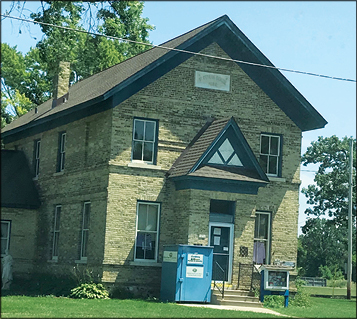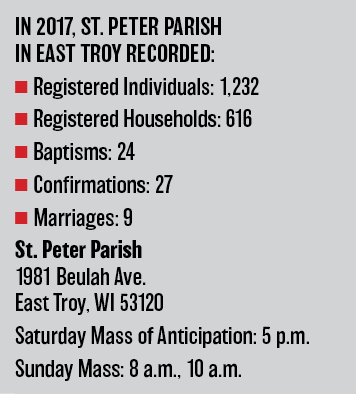
Top: The exterior of St. Peter Parish, which has stood in that spot since the late 1800s. Above: The baptismal font inside the church.
On the day the parish bell was installed and blessed in 1880, Michael Rush, who lived next door to the parish, promised to ring the bell three times a day for the rest of his life. After his death, his wife, known to many in the parish as “Grandma Rush,” continued the tradition until she could no longer pull the rope.
Almost 140 years has passed and the commitment of the community of St. Peter Parish in East Troy has not changed. While the community doesn’t focus on ringing the bell, the parishioners are involved in a number of outreach efforts not necessarily typical in a parish, especially a parish on the smaller side. It was something that struck Fr. Mark Molling, the pastor of St. Peter since 2014, when he first arrived.
“Even though I considered it a small parish, it’s got a vitality to it that’s bigger,” he said. “People are active in a number of things around this place, and not necessarily in the standard kind of ways.”
For example, the parish does not have a St. Vincent de Paul chapter, so many parishioners are involved in Helping Hands, the parish’s clothing center that also helps those in need with financial assistance. A group within the parish is dedicated to visiting the sick and taking communion to them regularly, another group organizes a prayer service once a week at the jail, and another group of women go to Elkhorn and pray outside of the Planned Parenthood office. All of these are activities “that you wouldn’t expect in a small parish, but are being done here because there are people who are very committed and interested and reaching out in those kind of ways,” Fr. Mark said.
Parishioner, Director of Religious Education and Pastoral Associate Suzanne Kasper loves the drive her fellow parishioners have for performing works of mercy. “I love the missionaries that go far and wide, but I believe that we have to see who’s in our own community.”
Personally, she’s taken that call seriously, and formed Gerard’s Embrace, a house for women and new babies in crisis, located next door to the parish, within the last two years. While Gerard’s Embrace is a non-profit of its own, the idea was initiated in the parish and many parish members are supportive of the mission.
But Gerard’s Embrace, with its first resident arriving this week, is just the newest chapter in a church and a community that celebrated its centennial almost 50 years ago. The parish’s story starts in 1851 with Fr. Martin Kundig, who organized a mission parish in East Troy, holding services in homes once a month. Three years later, a frame church was built and named St. Thaddeus. Bishop Henni dedicated the church on Nov. 9, 1856.
About a decade later, as the parish was rapidly growing, Alex and James Porter donated land on Beulah Avenue and another site for a cemetery. Parishioners worked hard to help build a new church, hauling stone from a quarry near Potter’s Lake. The church that still stands today was finished in 1872.
Around the same time, Fr. John Casey, one of the pastors of St. Peter, established The Catholic Vindicator, the first Catholic weekly newspaper. Per Bishop Henni’s request, the newspaper offices were relocated to Milwaukee. Later on, the newspaper was named The Catholic Citizen, The Catholic Herald Citizen and has evolved into the publication today.
In 1888, a school was established, but closed within a decade because of small enrollment numbers and a lack of transportation. The frame of that school still stands across the street from the parish today.
Under the leadership of Fr. John Weinhoff in the early 20th century, the parish went through a period of growth and expansion. Within the next 20 years, a number of items were added to the church: a chapel, storeroom, priests’ quarters, a new sanctuary,
Stations of the Cross, a pipe organ and stained glass windows that still line the walls of the church. The windows were strengthened and restored within the last two years, said Fr. Mark.

Helping Hands is the community’s clothing center, which also helps with financial assistance. It is housed across the street from the parish.
The school that neighbors the parish today was established in 1962 and designed by Fr. John Goebel. In its early years, the school established a continuous progress learning method of instruction, meaning grade levels did not exist. This method was used in teaching subjects like math, spelling, grammar and reading.
Throughout the years, although the nature of East Troy changed from an agrarian culture to more of a suburban feel, the “church kept its pace,” noted the 1972 centennial history booklet.
But the church still has an agrarian feel to it, and that feel is attractive to its visitors, said Fr. Mark.
“The number one comment I hear is that people are impressed with the church,” he said. “They like the fact that it’s a country church, so to speak. But it’s a beautiful country church. It’s an old church, built in 1872. We’re trying to do the best we can to maintain it and keep it going.”
Coupled with the “country church” feel, the community is like a small town, where everyone knows each other. But that doesn’t mean the community is “uniform.” They agree to disagree on a variety of topics.
“They don’t necessarily agree, but they’re still there next to each other and they’re there to help each other and support each other,” Fr. Mark said.
Kasper can attest to the small-town atmosphere. “The whole community comes out for everything,” she said. “When we host our festival, everyone goes to it, even people who aren’t members (of the parish). We have our unique small-town things.”
Members of St. Peter don’t just come from the center of East Troy; many come from the lake community and some are farmers. They’re faithful in attending Mass, Fr. Mark said, not only on Sundays, but also during the weekdays. He’ll see 40 to 50 people at daily Mass. Along with Mass attendance, Fr. Mark said he is impressed with the prayer life of the community. 
“I’m happy the prayer life of the parish is picking up. In the last few years, we’ve had a growing number of prayer groups that have started coming together,” he said, mentioning a weekly men’s and women’s group.
To parishioners, the parish is more than just a place where they pray and attend Mass. Many parishioners call the parish a “special place.” Parishioner Bill Hubbard was baptized, confirmed and received his first Eucharist and first confession in the parish.
For him, the parish is home.
“It’s always felt like a home,” he said. “It’s a very welcoming atmosphere with very caring people.”
“I think we’re a hidden, almost unknown gem in the archdiocese,” Fr. Mark said. “I think a lot of people fly by us on (Interstate) 43. I think we’re worth a little bit of a stop to come by and see us and see what we offer.”
